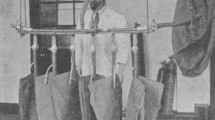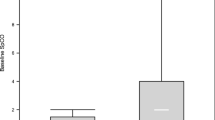Abstract
Total haemoglobin mass can be easily measured by applying the optimised CO-rebreathing method (oCOR-method). Prerequisite for its accurate determination is a homogenous CO distribution in the blood and the exact knowledge of the CO volume circulating in the vascular space. The aim of the study was to evaluate the mixing time of CO in the blood after inhaling a CO-bolus and to quantify the CO volume leaving the vascular bed due to diffusion to myoglobin and due to exhalation during processing the oCOR-method. The oCOR-method was also compared to a former commonly used CO-rebreathing procedure. In ten subjects, the time course of carboxy-haemoglobin (HbCO) formation was analysed simultaneously in capillary and venous blood for a period of 15 min after inhaling a CO bolus. The volume of CO diffusing from haemoglobin to myoglobin was calculated via the decrease of HbCO. As part of this decrease is due to CO exhalation, this volume was quantified by collecting the exhaled air in a Douglas bag system. Equal HbCO values in capillary and venous blood were reached at min 6 indicating complete mixing of CO. The loss of CO out of the vascular bed due to exhalation and due to diffusion to myoglobin was 0.32 ± 0.12% min−1 (0.25 ± 0.09 ml min−1) and 0.32 ± 0.18% min−1 (0.24 ± 0.13 ml min−1) of the administered CO volume, respectively. The loss of CO due to exhalation and diffusion to myoglobin is of minor impact. It should, however, be considered by using correction factors to obtain high accuracy when determining total haemoglobin mass.






Similar content being viewed by others
References
Beningus VA, Hazucha MJ, Smith MV, Bromberg PA (1994) Prediction of carboxyhemoglobin formation due to transient exposure to carbone monoxide. J Appl Physiol 76:1739–1745
Bland JM, Altman DG (1986) Statistical methods for assessing agreement between two methods of clinical measurement. Lancet 8476:307–310
Brown E, Hopper J, Sampson JJ, Mudrick C (1951) Venous congestion of the extremities in relation to blood volume determinations and mixing curves of carbon monoxide and T-1824 in normal human subjects. J Clin Invest 30:1441–1451
Bruce EN, Bruce MC (2003) A multicompartment model of carboxyhemoglobin and carboxymyoglobin responses to inhalation of carbon monoxide. J Appl Physiol 95:1235–1247
Burge CM, Skinner SL (1995) Determination of hemoglobin mass and blood volume with CO: evaluation and application of a method. J Appl Physiol 79:623–631
Dahms TE, Horvath SM (1974) Rapid, accurate technique for determination of carbon monoxide in blood. Clin Chem 20(5):533–537
Gibson JG, Evans WA Jr (1937) Clinical studies of the blood volume. I. Clinical application of a method employing the azo dye “Evans Blue” and the spectrophotometer. J Clin Invest 16:301–316
Glass HI, Brant A, Clark JC, De Garreta AC, Day LG (1968) Measurement of blood volume using red cells labeled with radioactive carbon monoxide. J Nucl Med 9:571–575
Gore CJ, Hopkins WG, Burge CM (2005) Errors of measurment for blood volume parameters: a meta-analysis. J Appl Physiol 99:1745–1758
Gore CJ, Bourdon PC, Woolford SM, Ostler LM, Eastwood A, Scroop GC (2006) Time and sample site dependency of the optimized CO-Rebreathing method. Med Sci Sport Exerc 38:1187–1193
Gray SJ, Sterling K (1950) Determination of circulating red cell volume by radioactive chromium. Science 112:179–180
Heinicke K, Wolfahrt B, Winchenbach P, Biermann B, Schmid A, Huber G, Friedmann B, Schmidt W (2001) Blood volume and hemoglobin mass in elite athletes of different disciplines. Int J Sports Med 22:504–512
Hütler M, Beneke R, Böning D (2000) Determination of circulating hemoglobin mass and related quantities by using capillary blood. Med Sci Sports Exerc 32: 1024–1027
Hütler M, Beneke R, Littschwager A, Böning D (2001) Measured fraction of caboxyhaemoglobin depends on oxygen saturation of haemoglobin. Scand J Clin Lab Invest 61:83–86
Joels N, Pugh LGCE (1958) The carbon monoxide dissociation curve of human blood. J Physiol 142:63–77
Kisch H, Leucht S, Lichtwarck-Schoff M, Pfeiffer UJ (1995) Accuracy and reproducibility of the measurement of actively circulating blood volume with an integrated fiberoptic monitoring system. Crit Care Med 23:885–893
Noble RP, Gregersen I, Porter PM, Buckman A (1946) Blood volume in clinical shock. I. Mixing time and disappearance rate of T-1824 in normal subjects and in patients shock, determination of plasma volume in man from 10-minute sample. J Clin Invest 25:158–171
Sawka MN, Coyle EF (1999) Influence of body water and blood volume on thermoregulation and exercise performance in the heat. Exerc Sport Sci Rev 27:167–218
Sawka MN, Convertino VA, Eichner ER, Schnieder SM, Young AJ (2000) Blood volume: importance and adaptions to exercise training, environmental stresses, and trauma /sickness. Med Sci Sports Exerc 32:332–348
Schmidt W, Prommer N (2005) The optimised CO-rebreathing method: a new tool to determine total haemoglobin mass routinely. Eur J Appl Physiol 95:486–495
Stewart RD (1975) The effect of carbon monoxide on humans. Annu Rev Pharmacol 15:409–423
Thomsen JK, Fogh-Andersen N, Bulow K, Devantier A (1991) Blood and plasma volumes determined by carbon monoxide gas, 99 m Tc-labelled erxthrocytes, 125I-albumin and the T 1824 technique. Scand J Clin Lab Invest 51:185–190
West JB (1995) Pulmonary pathophysology-the essentials. Batimore: Williams & Wilkins. 3rd Edition
Acknowledgment
The study was financially supported by the German Federal Institute of Sport Science (BISp) No. VF 0407/03/42/2003–2004. We thank Stefan Knirsch for his excellent technical assistance.
Author information
Authors and Affiliations
Corresponding author
Rights and permissions
About this article
Cite this article
Prommer, N., Schmidt, W. Loss of CO from the intravascular bed and its impact on the optimised CO-rebreathing method. Eur J Appl Physiol 100, 383–391 (2007). https://doi.org/10.1007/s00421-007-0439-2
Accepted:
Published:
Issue Date:
DOI: https://doi.org/10.1007/s00421-007-0439-2




